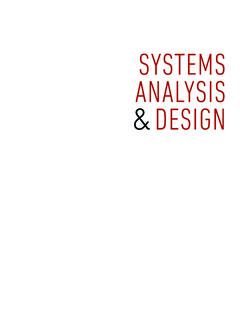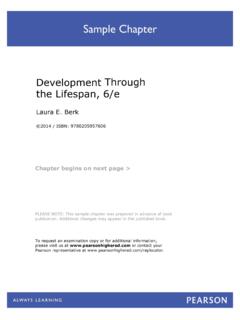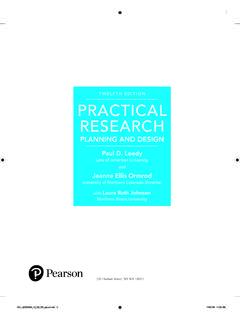Transcription of Research Methods, Design, and Analysis - Pearson
1 Research Methods, Design, and AnalysisTWELFTH EdiTionLarry B. ChristensenUniversity of South AlabamaR. Burke JohnsonUniversity of South AlabamaLisa A. TurnerUniversity of South AlabamaBoston Columbus Indianapolis New York San Francisco Upper Saddle RiverAmsterdam Cape Town Dubai London Madrid Milan Munich Paris Montr al TorontoDelhi Mexico City S o Paulo Sydney Hong Kong Seoul Singapore Taipei 108/06/13 5:41 PMExecutive Editor: Stephen FrailEditorial Assistant: Caroline Beimford Marketing Manager: Jeremy IntalDigital Media Editor: Lisa DotsonMedia Project Manager: Pam WeldinManaging Editor: Linda BehrensProduction Project Manager: Maria PiperSenior Operations Supervisor: Mary FischerOperations Specialist: Diane PeiranoArt Director, Cover: Jayne ConteCover Designer: Bruce KenselaarCover Art.
2 Deco/AlamyFull-Service Project Management: Anandakrishnan Natarajan/Integra Software Services, Ltd. Composition: Integra Software Services, : Courier/WestfordCover Printer: Lehigh-Phoenix Color/HagerstownCredits and acknowledgments borrowed from other sources and reproduced, with permission, in this textbook appear on the appropriate page within 2014, 2011, 2007 Pearson Education, Inc. All rights reserved. Manufactured in the United States of America. This publication is protected by Copyright, and permission should be obtained from the publisher prior to any prohibited reproduction, storage in a retrieval system, or transmission in any form or by any means, electronic, mechanical, photocopying, recording, or likewise. To obtain permission(s) to use material from this work, please submit a written request to Pearson Education, Inc.
3 , Permissions Department, One Lake Street, Upper Saddle River, New Jersey 07458, or you may fax your request to of the designations by manufacturers and sellers to distinguish their products are claimed as trademarks. Where those designations appear in this book, and the publisher was aware of a trademark claim, the designations have been printed in initial caps or all of Congress Cataloging-in-Publication DataChristensen, Larry B., [Experimental methodology] Research methods, design, and Analysis /Larry B. Christensen, University of South Alabama, R. Burke Johnson, University of South Alabama, Lisa A. Turner, University of South Alabama. twelfth edition . pages cm ISBN-13: 978-0-205-96125-2 (alk. paper) ISBN-10: 0-205-96125-8 (alk. paper) 1. Psychology, Experimental Textbooks. 2. Psychology Experiments Textbooks.
4 3. Experimental design. I. Johnson, Burke. II. Turner, Lisa Anne. III. 4 dc23 201301029510 9 8 7 6 5 4 3 2 1 ISBN-10: 0-205-96125-8 ISBN-13: 208/06/13 5:41 PMBrief ContentsParT i Introduction | 1 1. Introduction to Scientific Research | 1 2. Research Approaches and Methods of Data Collection | 25 ParT ii Planning the Research Study | 63 3. Problem Identification and Hypothesis Formation | 63 4. Ethics | 88 ParT iii Foundations of Research | 131 5. Measuring Variables and Sampling | 131 6. Research Validity | 158 ParT iV Experimental Methods | 187 7. Control Techniques in Experimental Research | 187 8.
5 Experimental Research Design | 217 9. Procedure for Conducting an Experiment | 249 10. Quasi-Experimental Designs | 269 11. Single-Case Research Designs | 291 ParT V Survey, Qualitative, and Mixed Methods Research | 313 12. Survey Research | 313 13. Qualitative and Mixed Methods Research | 342 ParT Vi Analyzing and Interpreting Data | 373 14. Descriptive Statistics | 373 15. Inferential Statistics | 308/06/13 5:41 PMiv | Brief ContentsParT Vii Writing the Research Report | 447 16. Preparing the Research Report for Presentation or Publication | 447 Appendix | 479 Glossary | 480 References | 495 Index | 408/06/13 5:41 PMContentsPreface | xviiParT i Introduction | 1 CHaPTEr 1 Introduction to Scientific Research | 1 Introduction | 2 Methods of Acquiring Knowledge | 3 Intuition | 3 Authority | 4 Rationalism | 4 Empiricism | 5 Science | 6 Induction and Deduction | 6 Hypothesis Testing | 7 Naturalism | 8 Kuhn and Paradigms | 9 Feyerabend s Anarchistic Theory of Science | 9 What Exactly Is Science?
6 | 10 Basic Assumptions Underlying Scientific Research | 11 Uniformity or Regularity in Nature | 11 Reality in Nature | 11 Discoverability | 12 Characteristics of Scientific Research | 12 Control | 12 Operationalism | 13 Replication | 14 The Role of Theory in Scientific Research | 15 The Role of the Scientist in Psychological Research | 16 Curiosity | 16 Patience | 17 Objectivity | 17 Change | 508/06/13 5:41 PMvi | ContentsObjectives of Psychological Research | 18 Description | 18 Explanation | 18 Prediction | 19 Control or Influence | 19 Pseudoscience | 20 Summary | 20 Key Terms and Concepts | 22 Related Internet Sites | 22 Practice Test | 22 Challenge Exercises | 23 CHaPTEr 2 Research Approaches and Methods of Data Collection | 25 Introduction | 26 Variables in Quantitative Research | 27 Experimental Research | 29 Causation | 30 Cause | 30 Effect | 30 Required Conditions for Making the Claim of Causation | 31 The Psychological Experiment | 321.
7 Objective Observation | 32 2. Of Phenomena That Are Made to Occur | 32 3. In a Strictly Controlled Situation in Which One or More Factors Are Varied and the Others Are Kept Constant | 33 Example of an Experiment and Its Logic | 33 Advantages of the Experimental Approach | 351. Causal Inference | 35 2. Ability to Manipulate Variables | 36 3. Control | 36 Disadvantages of the Experimental Approach | 361. Does Not Test Effects of Nonmanipulated Variables | 36 2. Artificiality | 37 3. Inadequate Method of Scientific Inquiry | 37 Experimental Research Settings | 37 Field Experiments | 37 Laboratory Experiments | 39 Internet Experiments | 39 Nonexperimental Quantitative Research | 40 Correlational Study | 41 Natural Manipulation Research | 44 Cross-Sectional and Longitudinal Studies | 46 Qualitative Research | 48 Major Methods of Data Collection | 50 Tests | 50 Questionnaires | 51 Interviews | 52 Focus Groups | 608/06/13 5.
8 41 PMContents | viiObservation | 54 Existing or Secondary Data | 55 Summary | 58 Key Terms and Concepts | 59 Related Internet Sites | 60 Practice Test | 60 Challenge Exercises | 61 ParT ii Planning the Research Study | 63 CHaPTEr 3 Problem Identification and Hypothesis Formation | 63 Introduction | 63 Sources of Research Ideas | 64 Everyday Life | 64 Practical Issues | 65 Past Research | 65 Theory | 65 Bias in Research Ideas | 67 Ideas Not Capable of Scientific Investigation | 67 Review of the Literature | 68 Getting Started | 69 Defining Objectives | 69 Doing the Search | 69 Books | 69 Psychological Journals | 70 Computerized or Electronic Databases | 70 Internet Resources | 73 Obtaining Resources | 78 Additional Information Sources | 78 Feasibility of the Study | 79 Formulating the Research Problem | 80 Defining the Research Problem | 80 Specificity of the Research Question | 81 Formulating Hypotheses | 82 Summary | 84 Key Terms and Concepts | 85 Related Internet Sites | 85 Practice Test | 85 Challenge Exercises | 86 CHaPTEr 4 Ethics | 88 Introduction | 89 Research Ethics: What Are They?
9 | 89 Relationship Between Society and Science | 89 Professional Issues | 90 Treatment of Research Participants | 708/06/13 5:41 PMviii | ContentsEthical Dilemmas | 93 Ethical Guidelines | 98 Beneficence and Nonmaleficence | 100 Fidelity and Responsibility | 102 Integrity | 102 Justice | 103 Respect for People s Rights and Dignity | 103 APA Ethical Standards for Research | 104 Ethical Issues to Consider When Conducting Research | 104 Institutional Approval | 104 Informed Consent | 105 Dispensing With Informed Consent | 105 Informed Consent and Minors | 107 Passive Versus Active Consent | 107 Deception | 109 Debriefing | 111 Coercion and Freedom to Decline Participation | 113 Confidentiality, Anonymity, and the Concept of Privacy | 114 Ethical Issues in Electronic Research | 116 Informed Consent and Internet Research | 116 Privacy and Internet Research | 117 Debriefing and Internet Research | 118 Ethical Issues in Preparing the Research Report | 118 Authorship | 119 Writing the Research Report | 119 Ethics of Animal (Nonhuman) Research | 120 Safeguards in the Use of Animals | 120 Animal Research Guidelines | 121I.
10 Justification of the Research | 121II. Personnel | 122 III. Care and Housing of Animals | 122IV. Acquisition of Animals | 122V. Experimental Procedures | 123VI. Field Research | 124 VII. Educational Use of Animals | 124 Summary | 124 Key Terms and Concepts | 126 Related Internet Sites | 127 Practice Test | 127 Challenge Exercises | 128 ParT iii Foundations of Research | 131 CHaPTEr 5 Measuring Variables and Sampling | 131 Introduction | 132 Defining Measurement | 808/06/13 5:41 PMContents | ixScales of Measurement | 132 Nominal Scale | 133 Ordinal Scale | 133 Interval Scale | 133 Ratio Scale | 134 Psychometric Properties of Good Measurement | 134 Overview of Reliability and Validity | 134 Reliability | 135 Test Retest Reliability | 135 Equivalent-Forms Reliability | 135 Internal Consistency Reliability | 135 Interrater Reliability | 136 Validity | 136 Validity Evidence Based on Content | 138 Validity Evidence Based on Internal Structure | 138 Validity Evidence Based on Relations to Other Variables | 139 Using Reliability and Validity Information | 140 Sources of Information About Tests | 141 Sampling Methods | 141 Terminology Used in Sampling | 141 Random Sampling Techniques | 144 Simple Random Sampling | 145 Stratified Random Sampling | 146










